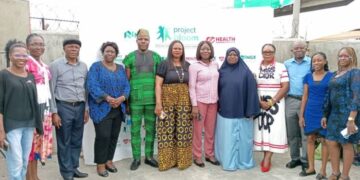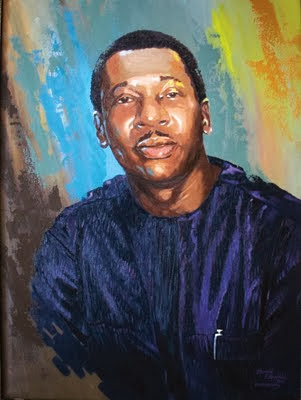for Contemporary Art, Lagos will present a third
solo exhibition by Kelani Abass, titled ‘Àsìkò: Evoking Personal
Narratives and Collective History’ from October 26 to December 21.
explores the possibilities inherent in painting, photography and printing,
strategies already suggested in his 2009 solo exhibition titled ‘Man and
Machine’. In ‘Àsìkò’, he highlights personal stories against the background of
social and political events built around three interrelated bodies of work, which
also engages time and memory.
‘Family Portrait’ series. Instead of portraits of people, an object, the first
typewriter purchased by his mother to start the family printing business, is
used to signify the beginning of the story of the family’s trajectory.
this series, the painted image of the printing press is positioned full frontal
and centrally reinforcing the importance of the object and the way in which
time is inextricably implicated through technological development and its
symbolic entanglement with the family history.
The second body of paintings, the ‘Calendar series,’ Kelani appropriates the
template of the ‘Bomode Oku,’ an engaging way of telling stories and
remembering events that have happened in a community.
coming to the family printing press with images of a loved one (usually
deceased) and asking for a ‘Bomode Oku’ calendar that highlights the story of
their town and community.
archiving and remembering and uses it for his own purposes in the ‘Calendar
Series’ by superimposing within the painting, images of his late father,
maternal grandfather and grandmother to create his own family ‘Bomode Oku’.
history of the family’s origin in Abeokuta by creating calendars of two
important Yoruba Kings, Oba Gbadebo I and Oba Ademola II whose reign in the
late 19th and early 20th Century had an impact
on the South -West Region of Nigeria.
The last series, ‘Family Album,’ are
large paintings embedded with photographs that place the nuclear family within
the group at social gatherings and important events. By making a private
narrative part of the social collective, he comments on the universal reality
of his experience.
past and present, analogue and digital, painting and photograph combine
seamlessly, combining space, time, and medium.
a nostalgic as well as a therapeutic tribute to a father, who despite the passage
of time, his memories remain embedded in the fabric of the present. This is
most visible with the inclusion of a book of ‘knowledge’, a material witness to
the thoughts, ideas and encounters of the artist’s father, late Alhaji Sumola
Ajani Kelani.
The arrival of Kelani Abass at this personal and professional juncture can
better be understood through the local context and environment in which the
works are created. ‘Àsìkò’ is a critical and artistic milestone that has
accumulated over the past four years through a search for a personal visual
language borne out of lived experiences.
opportunities that involved exploring, experimenting, collaboration, research
and critical thinking. As with many painters, Kelani uses
photography as a preparatory tool for his work, but very few artists in Nigeria
have placed it on the same level as painting, reinforcing hierarchical barriers
between the ‘art’ of painting and mechanical procedure of
photography.
barriers, which is evidenced in this body of work signal a new departure in the
relationship between painting and photography in Nigeria? On this occasion,
painting is presented with photography, printing and even the performance, not
as a support, but as part of the expanded field of contemporary art practice.
and constraints of his educational background and artistic environment;
allowing him to weave a complex narrative of fact, fiction, mediums and
materials that comment on the family, technology, time history and
politics.
Kelani Abass (1979) studied at the Yaba College of Art and Technology
where he graduated with a distinction in painting. Since then he has had two
solo exhibitions, ‘Paradigm Shift’ (2009) and ‘Man and Machine’ (2011).
exhibitions in Nigeria and South Africa. Kelani has won several awards and
prizes including 1st prize in painting of the Caterina de
Medici/3rd Black Heritage Prize (2010), the Yusuf Grillo Award for best painting
student at Yabatech (2007).
residencies and workshops. He is a member of the Society of Nigerian Artists.































































very informative,
great write up.
ezechimereuchenna.blogspot.com
examine sensible, easy. Figure out the most beneficial learning method that performs for you personally. Are you currently somebody whom works well having sound recording, image as well as nurse practitioner certification Once you've got that fixed out there, you'd realize how to help make your notices along with you skill to create learning far better
Hey Carissa,
Thanks for the comment. I think its all of the above: self assessment, group assessment, and teacher assessment are the perfect cocktail for assessment that counts for a grade. Thanks for the thoughtful blog idea! london counselling directory